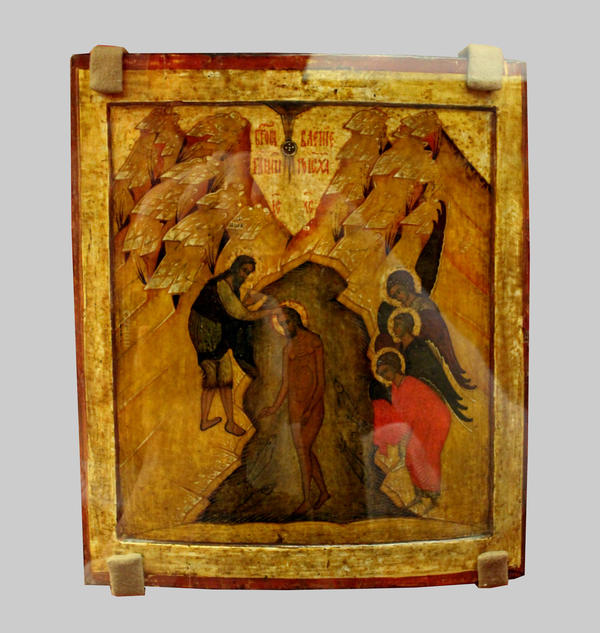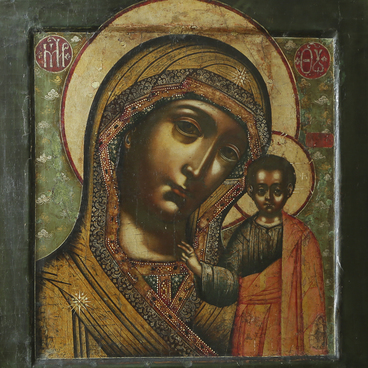The icon The Epiphany of the Lord Jesus Christ is traditionally placed in the second, festive row of the iconostasis among other icons of the twelve holy days — twelve important events of the gospel history. Epiphany or Baptism in Orthodoxy is celebrated in a new style on January 19. This date concludes the Christmas time — twelve holidays from Christmas to Epiphany Eve.
Baptism is one of the seven church sacraments. It symbolizes the rebirth of man: according to the teachings of the church, during the ceremony he dies for carnal life and is reborn for spiritual life. After the holiday, Orthodox believers should have the Great Pentecost or Great Lent. According to the Gospels, after baptism, Jesus retired to the wilderness, where he prayed and fasted for forty days.
The icon tells how John the Baptist baptized Jesus Christ in the waters of the Jordan. The evangelists Matthew, Mark, Luke and John testified that at that moment, the heavens opened and the Holy Spirit descended on Jesus in the form of a dove. The voice of God the Father from heaven proclaimed: ‘This is my beloved Son, whom I am pleased very much with.’ So the Holy Trinity revealed themselves to the world. Therefore, the feast of Baptism has the second name, Epiphany. Jesus Christ is depicted completely immersed in the waters of the river, John the Baptist laid his hand on his head. The banks of the Jordan resemble a gorge or a coffin — this is a reference to the fact that the baptismal rite represents death for a subsequent rebirth and eternal life. From above, rays of light fall upon Christ, in which a dove is depicted — a symbol of the Holy Spirit.
Small fish scurry about at the feet of Christ. The image of the fish was one of the symbols of God: the ancient Greek word is translated as ‘ichthys’, and these are the first letters of the phrase ‘Jesus Christ the Son of God the Savior.’ In the Roman catacombs, where Christians gathered, drawings of fish created in the 2nd century AD were discovered. The plot of Baptism, like other events of the Gospel history, was depicted in accordance with the strict canon. But within the framework of the canonical image, there were permissible versions of iconography — they were called exiles. In the exiled icon from the collection of the Primorye State Picture Gallery, the artist painted Jesus naked, turning to John the Baptist. And the angels are located one above the other, in similar poses. These features make it possible to attribute the icon to the Novgorod school of icon painting in the mid-16th century. This is also evidenced by a strict chased pattern, large shapes and bright saturated colors.
Baptism is one of the seven church sacraments. It symbolizes the rebirth of man: according to the teachings of the church, during the ceremony he dies for carnal life and is reborn for spiritual life. After the holiday, Orthodox believers should have the Great Pentecost or Great Lent. According to the Gospels, after baptism, Jesus retired to the wilderness, where he prayed and fasted for forty days.
The icon tells how John the Baptist baptized Jesus Christ in the waters of the Jordan. The evangelists Matthew, Mark, Luke and John testified that at that moment, the heavens opened and the Holy Spirit descended on Jesus in the form of a dove. The voice of God the Father from heaven proclaimed: ‘This is my beloved Son, whom I am pleased very much with.’ So the Holy Trinity revealed themselves to the world. Therefore, the feast of Baptism has the second name, Epiphany. Jesus Christ is depicted completely immersed in the waters of the river, John the Baptist laid his hand on his head. The banks of the Jordan resemble a gorge or a coffin — this is a reference to the fact that the baptismal rite represents death for a subsequent rebirth and eternal life. From above, rays of light fall upon Christ, in which a dove is depicted — a symbol of the Holy Spirit.
Small fish scurry about at the feet of Christ. The image of the fish was one of the symbols of God: the ancient Greek word is translated as ‘ichthys’, and these are the first letters of the phrase ‘Jesus Christ the Son of God the Savior.’ In the Roman catacombs, where Christians gathered, drawings of fish created in the 2nd century AD were discovered. The plot of Baptism, like other events of the Gospel history, was depicted in accordance with the strict canon. But within the framework of the canonical image, there were permissible versions of iconography — they were called exiles. In the exiled icon from the collection of the Primorye State Picture Gallery, the artist painted Jesus naked, turning to John the Baptist. And the angels are located one above the other, in similar poses. These features make it possible to attribute the icon to the Novgorod school of icon painting in the mid-16th century. This is also evidenced by a strict chased pattern, large shapes and bright saturated colors.



